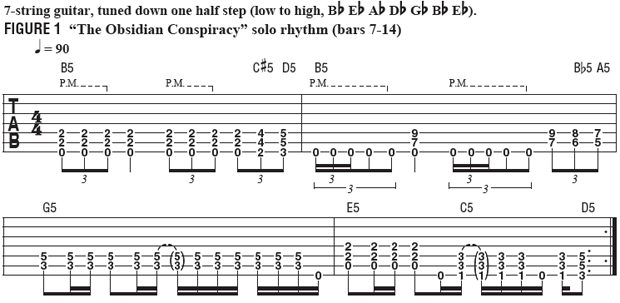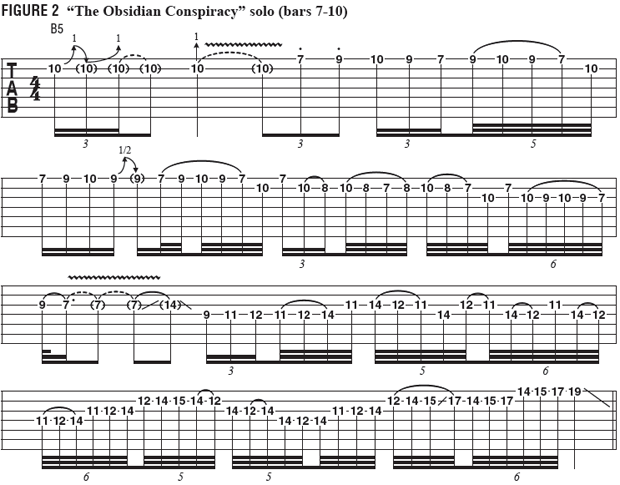Merchant of Menace with Jeff Loomis: Traversing Natural Minor-Scale Positions, and “The Obsidian Conspiracy” Solo, Part 2

Last month, we dissected the first six bars of the guitar solo section in the title track of Nevermore’s latest release, The Obsidian Conspiracy.
Let’s pick up where we left off and take a detailed look at the rhythm and lead parts I play over bars 7–10 of the solo section.
We’ll begin with the rhythm guitar part, illustrated in FIGURE 1. At this point in the section, I basically shift back and forth between the I (one) chord, B5, the fVI (flat six) chord, G5, and the IV (four), E5, with a few additional chords thrown in for color.
I start in bar 1 with a low B5 voicing, played on the bottom three strings, shifting up to C#5 and D5 at the end of the bar. This rhythm pattern is based primarily on eighth-note triplets, with palm muting employed on beats one and three to fortify the power of the rhythm part.
In bar 2, I move the B5 voicing up an octave, fretting the sixth and fifth strings along with the open low B. Another way I add emphasis to the rhythm is by quickly alternate picking 16th-note triplets on the open low B on beats one and three. At the end of this bar, I slide the two-note power chord shape down chromatically (one fret at a time), setting up the shift to G5 at the beginning of bar 3.
- Across bars 3 and 4, I strum the power chords primarily in a 16th-note rhythm and end the figure on beat four of bar 4 with a quick shift from C5 to D5. I like to fret these three-note power chords with the index finger on the seventh string and the pinkie
- barred across the sixth and fifth strings.
FIGURE 2 shows the lead guitar part for bars 7–10 of the solo. All the lines I play through these four bars are based on the B natural minor scale (B C# D E F# G A), also known as the B Aeolian mode. For bars 1 and 2 of this excerpt, I stay “rooted” in seventh position, starting with a whole-step bend and vibrato on the high B string’s 10th fret, fretted with the ring finger.
Throughout this bar and into the following two beats, I like to use a “stretched” fret-hand posture, with the index, middle and ring fingers fretting the seventh, ninth and 10th frets, respectively. Like many guitarists, I like the strength and accuracy this three-finger approach affords.
All the latest guitar news, interviews, lessons, reviews, deals and more, direct to your inbox!
At the end of beat two in bar 2, however, I fret the A note at the high B string’s 10th fret with the pinkie, and from there I use all four digits to finger all the fast scalar runs through the remainder of the excerpt. Through these first two bars, notice also that I’m fairly evenly split between using straight alternate (down-up) picking and hammer-ons and pull-offs. Starting in bar 3, I rely more heavily on alternate picking, and by bar 4 I’m alternate picking almost exclusively, which, to my ears, adds more intensity as the solo progresses.
Another point of interest here is the way in which I connect five different positions of B natural minor, starting at beat three of bar 3: I begin in ninth position but shift immediately up to 11th position on the upbeat. The fast scalar phrases stay in this position until bar 4, wherein I shift up to 12th position, then 14th before ending the solo with a final shift up to 16th position. If you play through all these lines slowly and deliberately, you’ll see that these position shifts help facilitate a smooth performance.
I’ll be back next month with the last section of the “Obsidian Conspiracy” solo.


